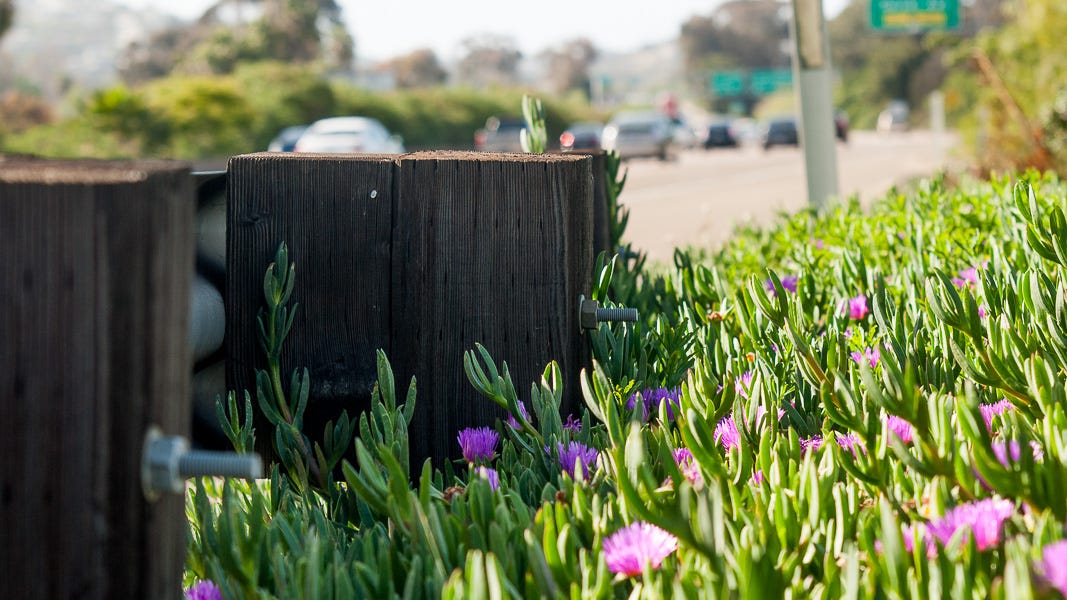Anita Schillhorn van Veen (ASVV) is a friend of WITI and has a few other WITIs under her belt (Climate Tourism & Utopias). She writes her own newsletter, which you can read here. -Colin (CJN)
Anita here. Some people say Los Angeles has no seasons. After three years here, I beg to differ. In the early summer, marine layers of fog cloud the skies, while in the late summer, the sun burns hot and desert plants dry up and turn inward, preserving their life force for when the cool arrives again—an inverse to plants that die off in the winter cold. From January onwards, different plants burst forth with blooms: magnolias and acacias, succulents with their awkward chunky blossoms, California lilacs, architectural passion fruit flowers, and of course the California state flower, the poppy, creating endless fields of orange in good years.
One plant that flowers beautifully but is actually quite beastly is the ice plant. In March and April, it peppers beach areas with white and purple blooms the size of a small human hand. They’re stunning in bloom, and even when the flowers don’t freckle ice plant fields, the plant itself is quite handsome, with bold succulent leaves of about six inches, that grow into lush mats. It was initially introduced to California to prevent erosion, and as a fast-growing ornamental ground cover, and was planted widely in the 1930s by the California Conservation Corps.
The ice plant, or Carpobrotus edulis, is native to South Africa, where it lives a natural life cycle in a robust ecosystem including tortoises, antelopes, baboons, and porcupines.
In Los Angeles, we’re woefully short of those kinds of predators. And so the ice plant grows unabashed, taking over empty lots and sand dunes, where it chokes out native flora, and thereby starves native fauna. It’s also been found to increase the erosion it was intended to prevent, with shallow root systems and heavy leaves that easily tear up the very dunes it was meant to stabilize.
Why is this interesting?
According to the United States Geographical Survey, the ice plant is one of 65,000 non-indigenous invasive species that cost the US economy over $100 billion.
The introduction of new species to solve a challenge has led to many a horror story, from killer algae to zebra mussels. But the idea of a pre-invasive Eden can also be misleading. According to a piece from the Yale School of the Environment:
Simply trying to eradicate all exotic species can be costly... and can even harm native species. Introduced cats were eradicated from Maquarie Island off the coast of Australia, after having driven two of the island’s bird species extinct. But with the cats gone, an introduced population of rabbits exploded, devouring the native plants.
Scott Carroll, a conservation biologist at the University of California, Davis, is a proponent of ‘conciliation biology,’ which recognizes that the introduction of a new species already alters the environment and spurs evolution. Any changes that are made to the environment should be less about restoring it to the prior state and more about finding the right equilibrium with the new species—“a managed coexistence of native with nonnative (species).”
There may be a lesson here as we learn to live with the coronavirus, or even with new weather patterns induced by climate change. As we calibrate our world to new threats, the idea of a “managed coexistence” feels more realistic than seeking to return to some idyllic world of the past. (ASVV)
Movie of the Day:
I had totally forgotten that Kermit got into advertising after getting amnesia in the Muppets Take Manhattan. (NRB)
Quick Links:
@SubstackTooLong just tweets out word counts for popular Substacks (NRB)
Hospitality and positive impact (CJN)
Thanks for reading,
Noah (NRB) & Colin (CJN) & Anita (ASVV)
—
Why is this interesting? is a daily email from Noah Brier & Colin Nagy (and friends!) about interesting things. If you’ve enjoyed this edition, please consider forwarding it to a friend. If you’re reading it for the first time, consider subscribing (it’s free!).




